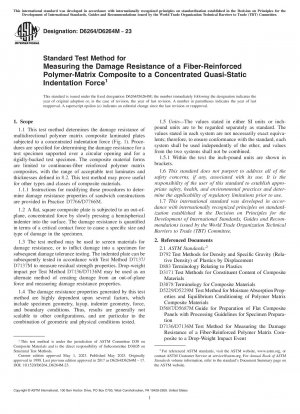ASTM D6264/D6264M-23
Standard Test Method for Measuring the Damage Resistance of a Fiber-Reinforced Polymer-Matrix Composite to a Concentrated Quasi-Static Indentation Force
- Standard No.
- ASTM D6264/D6264M-23
- Release Date
- 2023
- Published By
- American Society for Testing and Materials (ASTM)
- Latest
- ASTM D6264/D6264M-23
- Scope
- 1.1 This test method determines the damage resistance of multidirectional polymer matrix composite laminated plates subjected to a concentrated indentation force (Fig. 1 ). Procedures are specified for determining the damage resistance for a test specimen supported over a circular opening and for a rigidly-backed test specimen. The composite material forms are limited to continuous-fiber reinforced polymer matrix composites, with the range of acceptable test laminates and thicknesses defined in 8.2 . This test method may prove useful for other types and classes of composite materials. FIG. 1 Quasi-Static Indentation Test 1.1.1 Instructions for modifying these procedures to determine damage resistance properties of sandwich constructions are provided in Practice D7766/D7766M . 1.2 A flat, square composite plate is subjected to an out-of-plane, concentrated force by slowly pressing a hemispherical indenter into the surface. The damage resistance is quantified in terms of a critical contact force to cause a specific size and type of damage in the specimen. 1.3 The test method may be used to screen materials for damage resistance, or to inflict damage into a specimen for subsequent damage tolerance testing. The indented plate can be subsequently tested in accordance with Test Method D7137/D7137M to measure residual strength properties. Drop-weight impact per Test Method D7136/D7136M may be used as an alternate method of creating damage from an out-of-plane force and measuring damage resistance properties. 1.4 The damage resistance properties generated by this test method are highly dependent upon several factors, which include specimen geometry, layup, indenter geometry, force, and boundary conditions. Thus, results are generally not scalable to other configurations, and are particular to the combination of geometric and physical conditions tested. 1.5 Units— The values stated in either SI units or inch-pound units are to be regarded separately as standard. The values stated in each system are not necessarily exact equivalents; therefore, to ensure conformance with the standard, each system shall be used independently of the other, and values from the two systems shall not be combined. 1.5.1 Within the text the inch-pound units are shown in brackets. 1.6 This standard does not purport to address all of the safety concerns, if any, associated with its use. It is the responsibility of the user of this standard to establish appropriate safety, health, and environmental practices and determine the applicability of regulatory limitations prior to use. 1.7 This international standard was developed in accordance with internationally recognized principles on standardization established in the Decision on Principles for the Development of International Standards, Guides and Recommendations issued by the World Trade Organization Technical Barriers to Trade (TBT) Committee.
ASTM D6264/D6264M-23 Referenced Document
- ASTM D3171 Standard Test Methods for Constituent Content of Composite Materials
- ASTM D3878 Standard Terminology Composite Materials
- ASTM D5229/D5229M Standard Test Method for Moisture Absorption Properties and Equilibrium Conditioning of Polymer Matrix Composite Materials
- ASTM D5687/D5687M Standard Guide for Preparation of Flat Composite Panels with Processing Guidelines for Specimen Preparation
- ASTM D7136/D7136M Standard Test Method for Measuring the Damage Resistance of a Fiber-Reinforced Polymer Matrix Composite to a Drop-Weight Impact Event
- ASTM D7137/D7137M Standard Test Method for Compressive Residual Strength Properties of Damaged Polymer Matrix Composite Plates
- ASTM D7766/D7766M Standard Practice for Damage Resistance Testing of Sandwich Constructions
- ASTM D792 Standard Test Methods for Density and Specific Gravity (Relative Density) of Plastics by Displacement
- ASTM D883 Standard Terminology Relating to Plastics*, 2024-02-01 Update
- ASTM E122 Standard Practice for Calculating Sample Size to Estimate, With a Specified Tolerable Error, the Average for Characteristic of a Lot or Process
- ASTM E177 Standard Practice for Use of the Terms Precision and Bias in ASTM Test Methods
- ASTM E18 Standard Test Methods for Rockwell Hardness of Metallic Materials
- ASTM E2533 Standard Guide for Nondestructive Examination of Polymer Matrix Composites Used in Aerospace Applications
- ASTM E4 Standard Practices for Force Verification of Testing Machines
- ASTM E456 Standard Terminology for Relating to Quality and Statistics
- ASTM E6 Standard Terminology Relating to Methods of Mechanical Testing
ASTM D6264/D6264M-23 history
- 2023 ASTM D6264/D6264M-23 Standard Test Method for Measuring the Damage Resistance of a Fiber-Reinforced Polymer-Matrix Composite to a Concentrated Quasi-Static Indentation Force
- 2017 ASTM D6264/D6264M-17 Standard Test Method for Measuring the Damage Resistance of a Fiber-Reinforced Polymer-Matrix Composite to a Concentrated Quasi-Static Indentation Force
- 2012 ASTM D6264/D6264M-12 Standard Test Method for Measuring the Damage Resistance of a Fiber-Reinforced Polymer-Matrix Composite to a Concentrated Quasi-Static Indentation Force
- 2007 ASTM D6264/D6264M-07 Standard Test Method for Measuring the Damage Resistance of a Fiber-Reinforced Polymer-Matrix Composite to a Concentrated Quasi-Static Indentation Force
- 1998 ASTM D6264-98(2004) Standard Test Method for Measuring the Damage Resistance of a Fiber-Reinforced Polymer-Matrix Composite to a Concentrated Quasi-Static Indentation Force
- 1998 ASTM D6264-98 Standard Test Method for Measuring the Damage Resistance of a Fiber-Reinforced Polymer-Matrix Composite to a Concentrated Quasi-Static Indentation Force
